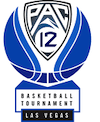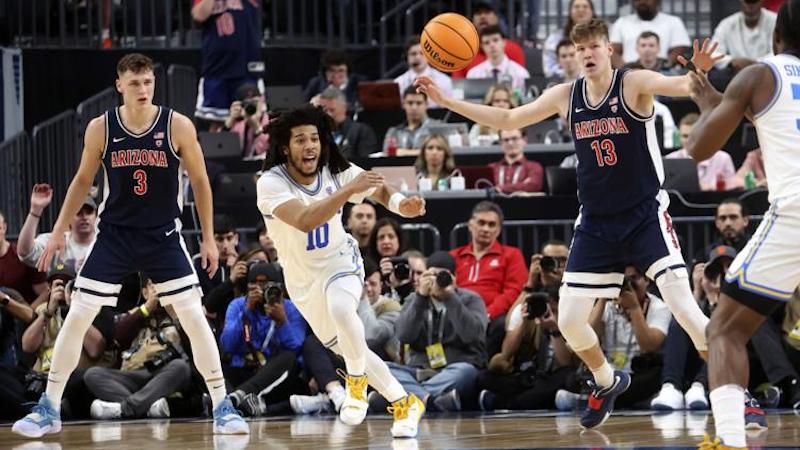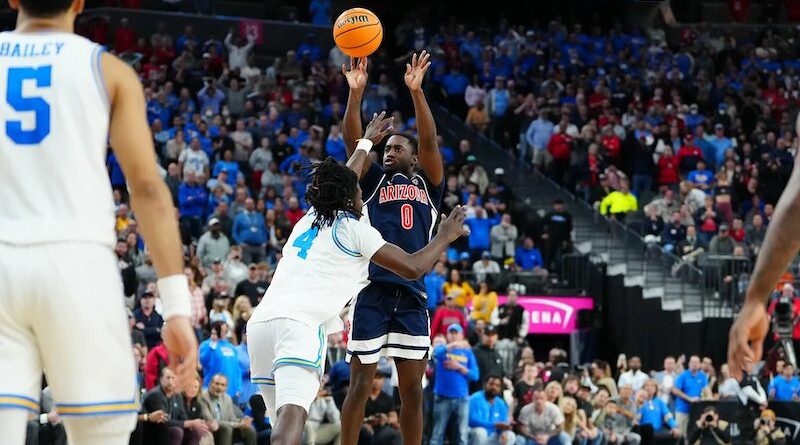Posted on March 12, 2023
|
 It was only fitting, in a matchup between the Pac-12’s two most storied men’s basketball teams, that the game would come down to the final shots in the final seconds.
It was only fitting, in a matchup between the Pac-12’s two most storied men’s basketball teams, that the game would come down to the final shots in the final seconds.
The Wildcats may have deprived the Bruins of a No. 1 seed in the NCAA Tournament with a 61-59 victory Saturday night in Las Vegas, but UCLA is far from down and out.
The Bruins entered the contest ranked second in the nation with an average of 8.6 more scoring chances per game than their opponents were getting.
A major reason for that was turnovers.
The Bruins don’t commit many, giving it away on 15.0 % of possessions this season, 26th in the nation. On the other end of the court, UCLA is forcing a turnover on 23.2% of possessions, 8th-best in the country.
Arizona is turning it over on 18.0% of possessions to rank 203rd in the country, forcing a turnover on just 16.7% of possessions, 242nd in America.
Obviously, the loss of Jaylen Clark loomed big for the Bruins, who clearly missed his defense, for which he ranks 18th in the nation with 1.219 steals per foul committed.

A primary concern for UCLA entering the game was going to be board presence, and whether they could control possessions against Arizona’s rebounding.
The Cats came in ranked 11th in the nation with a total rebound rate of 54.4%. The Bruins were also in the top 50 with a total rebound rate of 52.7%.
However, that number had fallen to just 44.7% against Oregon, and the absence of Adem Bona only exacerbated the issue.
The first half saw the Bruins +3 on extra scoring chances and +1 on the scoreboard. The odd part is that Arizona was +1 on turnovers forced and UCLA +4 on offensive rebounds.
Oumar Ballo was limited to just eight minutes in the first half due to foul trouble. That probably aided the Bruins in the rebounding battle before the break.
For the game, UCLA ended up +4 on scoring chances, and it stemmed from the Bruins forcing Arizona into turnovers.
The Bruins won the turnover battle, committing eight compared to 11 for Arizona.
But UCLA’s efficiency on those was not any better than what the Wildcats converted. Points off turnovers were 11-7 in favor of the Bruins with the points per TO being 1.0 for UCLA and 0.88 for Arizona.
The rebounding edge that UCLA enjoyed in the first half was not there in the second half, with the edge on the glass favoring the Wildcats 22-12 after halftime.

The second-chance opportunities favored Arizona 7-3, and second-chance points also were 9-2 in favor of the team from Tucson.
UCLA’s Kenneth Nwuba fouled out with 4:25 to play in the game, and after that, the glass completely belonged to Arizona, which outrebounded UCLA 7-3 from that point until the final buzzer.
The FT shooting for Arizona, which had not been good against ASU the previous night (6-14), was drastically improved in the final as the ‘Cats went 17-25, with Azuolas Tubelis knocking down 9 of 11.
Ultimately in this one Arizona’s size won out over UCLA, despite the efforts of Jaime Jaquez, Tyger Campbell, and Amari Bailey. Oumar Ballo drew eight fouls underneath to get the already limited Bruins post players into foul issues.
While Ramey only knocked down the one shot all day—the game-winner—he contributed seven rebounds.
With the win, the Wildcats notched their ninth all-time Pac-12 Tournament title.
Both the Bruins and Arizona will be getting high seeds in the NCAA Tournament and should be joined by Conference brethren and rivals USC and Arizona State.
We may even get a fourth meeting between these schools in Houston in a few weeks. It certainly would not disappoint.
—More from Stephen Vilardo—
- Stephen Vilardo’s SuperWest NFL Draft History Capsules
- Stephen Vilardo’s San Diego State-UConn Sweet 16 Preview
- Stephen Vilardo’s MW Second-Round Big Dance Previews
- Steve Vilardo’s MW Friday 1st-Round Big Dance Previews
- Stephen Vilardo’s Mountain West NCAA First Four Preview
- Stephen Vilardo’s 2024 Mtn West Tournament Title Preview
- Vilardo: Final 2024 MW Hoops Power Rankings & Outlook
- Stephen Vilardo’s ’23-24 WK 10 MW Hoops Power Rankings
- Stephen Vilardo’s 2023-24 WK 9 MW Hoops Power Rankings
- Stephen Vilardo’s 2023-24 WK 8 MW Hoops Power Rankings
- Stephen Vilardo’s 2023-24 WK 7 MW Hoops Power Rankings
- Stephen Vilardo’s 2024 NFL Super Bowl LVIII Preview
- Stephen Vilardo’s 2023-24 WK 6 MW Hoops Power Rankings
- Stephen Vilardo’s 2023-24 WK 5 MW Hoops Power Rankings
- Stephen Vilardo’s NFL Conference Championship Previews
-
Stephen Vilardo’s SuperWest NFL Draft History Capsules
A brief summary of each football program's player selection history at a glance - April 24, 2024 -
Stephen Vilardo’s San Diego State-UConn Sweet 16 Preview
Will the Aztecs be able to match the results from last season’s run against the Huskies? - March 28, 2024 -
Stephen Vilardo’s MW Second-Round Big Dance Previews
Three different teams won an NCAA Tournament game for the first time in conference history - March 24, 2024

